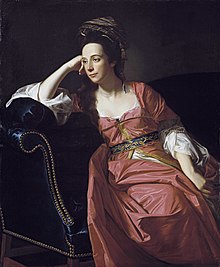|
Margaret Kemble Gage
Margaret Kemble Gage (1734–1824) was the wife of General Thomas Gage, who led the British Army in Massachusetts in the American Revolutionary War. It is alleged that she played an important role in the outcome of the American Revolution. She was suspected of having divided loyalties and informing the American Revolutionaries of British troop movements. Family life and descendantsMargaret Kemble was born in New Brunswick, Province of New Jersey, and lived in East Brunswick Township.[1][2][3] She was the daughter of Peter Kemble, a wealthy New Jersey businessman and politician, and Gertrude Bayard; the granddaughter of Judge Samuel Bayard (b. 1669) and Margaretta Van Cortlandt (b. 1674); and the great-granddaughter of Mayor of New York City Stephanus Van Cortlandt and Gertrude Schuyler.[1] Through her mother, she was a first cousin to the Van Cortlandts, de Lanceys, and the Van Rensselaers.[4] She married Thomas Gage on December 8, 1758, at her father's 1200-acre Mount Kemble Plantation in New Jersey.[5][6] Following the outbreak of the American Revolution, Kemble Gage sailed from Boston to England in the summer of 1776 on a ship carrying military widows, orphans, and 170 soldiers who had been badly wounded in the Battle of Bunker Hill. She was joined by her husband a few months later, who was recalled after his failure to resolve divisions with the colonists.[7] Together with their children, the couple settled in a Portland Place address in London. There are accounts that cite how Kemble Gage's relationship with her husband was never the same again.[8]  Margaret outlived Thomas Gage by 36 years. The couple had eleven children, and their first son, the future 3rd Viscount Gage, was born in Montreal in 1761. Gage's daughter, Charlotte Margaret Gage, married Admiral Sir Charles Ogle.[1] Descendants of Kemble Gage include:
Her brother, Stephen Kemble, was a lieutenant-colonel in the British Army during the Revolution.[1] She died in England in 1824. She was portrayed by Emily Berrington in the television miniseries Sons of Liberty. Role in American RevolutionCircumstantial evidence suggests that Kemble Gage may have played a key role in the lead-up to the first battle of the American Revolution (the Battle of Lexington and Concord).[9][10] Prior to the battle, the Sons of Liberty observed British troops in Boston preparing for action. Joseph Warren, one of the key leaders of the Sons of Liberty, learned from a confidential informer, well-connected to the British high command, "intelligence of their whole design...to arrest Samuel Adams and John Hancock, who were known to be at Lexington, and burn the colonists' military stores at Concord."[9][11] Warren, after learning of the plan, dispatched Paul Revere and William Dawes, which set off a chain reaction of alarm riders across Massachusetts and into adjoining colonies. Instead of a quiet night mission, the British troops were opposed by thousands of wide-awake, angry, armed colonists. Kemble Gage's husband, the British Commander-in-Chief, had intended to prevent a war, but was forced to send an additional 1,000 units to safely return the British force to Boston.[12][9] Warren's informant remains unknown, as two months later, he was killed during the Battle of Bunker Hill. Though the evidence is circumstantial, historians strongly suspect that the informant was Margaret Kemble Gage.[9][11][13][14] She was an American, and her family's prestige and wealth lent her social standing equal to that of her husband, whose officers were even known to call her "Duchess". She did not make a secret of her divided loyalties and said that "she hoped her husband would never be the instrument of sacrificing the lives of her countrymen".[11][15][16] General Gage stated later that he had only told two people of the plan, which was to be kept a "profound secret": his second-in-command, and one other person. Some of the other top British officers suspected that that other person was Margaret.[9][11] Before the engagements at Lexington and Concord, General Gage had been known as a devoted husband, but a year afterwards, Kemble Gage sailed to England at least temporarily without him.[9] See also
References
Sources
|
||||||||||||||

